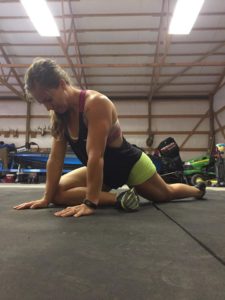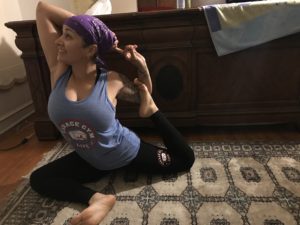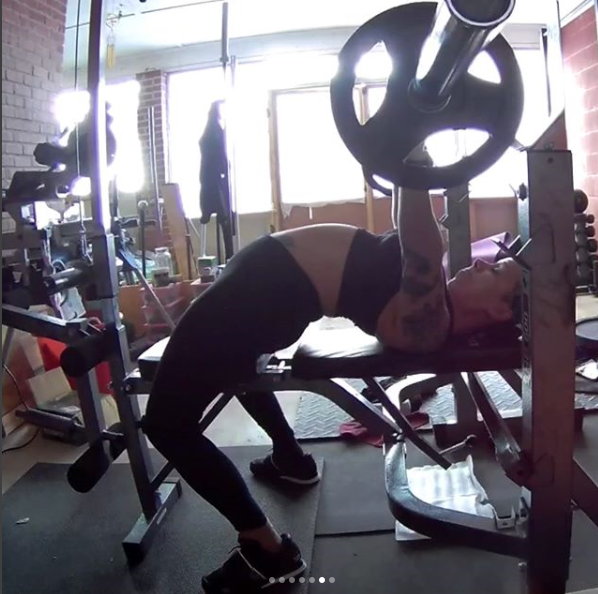Yoga Benefits For Lifters?
Yoga benefits lifters in several ways. For one thing, you probably already practice some yoga asanas (poses) without realizing it. Garland Pose for example is a deep squat. Anyway, we all know the benefits of a good stretch. We have all seen the cool and sometimes unusual photos on Instagram, maybe even tried a few poses with both disastrous and hilarious results. But what are the real benefits of yoga for a lifter?

What’s the quick and dirty, straight dope on how YOU, the everyday Garage Gym athlete, can benefit from this ancient practice?
The answer is both simple and complicated, just like yoga. The practice benefits powerlifters in the many ways but here are four:
Yoga Benefit #1 increases mental focus by perpetuating the state of inner calm that exists naturally within us all.
 A personal yoga practice develops the ability to focus in the moment. This is not saying the mind will not wander or thoughts do not arise at all; it’s actually the exact opposite. We learn to observe 50,000 thoughts a day and allow them to pass through us without grabbing on to them. We begin to recognize that thoughts are not what disrupt mental focus. Instead, it is our inability to distinguish thoughts from facts. We gradually decrease participation in each wild and random thought that crosses our minds. Yoga allows us to move physically through space while mentally stepping back into stillness to witness the beautiful noise inside, allowing it to become our background music rather than consuming our entire environment with dissonance. Anyone who has tried to PR a deadlift knows this place. From this place of calm is where we lift. This is where we decide that this weight will break from the ground; this is where that last ounce of push comes from when you are gasping for air with one round left to go on your WOD. Learning to exist in this state of perpetual calm is extraordinarily beneficial to lifters.
A personal yoga practice develops the ability to focus in the moment. This is not saying the mind will not wander or thoughts do not arise at all; it’s actually the exact opposite. We learn to observe 50,000 thoughts a day and allow them to pass through us without grabbing on to them. We begin to recognize that thoughts are not what disrupt mental focus. Instead, it is our inability to distinguish thoughts from facts. We gradually decrease participation in each wild and random thought that crosses our minds. Yoga allows us to move physically through space while mentally stepping back into stillness to witness the beautiful noise inside, allowing it to become our background music rather than consuming our entire environment with dissonance. Anyone who has tried to PR a deadlift knows this place. From this place of calm is where we lift. This is where we decide that this weight will break from the ground; this is where that last ounce of push comes from when you are gasping for air with one round left to go on your WOD. Learning to exist in this state of perpetual calm is extraordinarily beneficial to lifters.
Yoga Benefit #2 teaches the practitioner synchronicity of breath and helps to reinforce proper breathing.
No matter what activity you choose as a sport, knowing how to breathe is essential. Breathing is a passive activity most people are largely unaware of until they can no longer do so. Yoga focuses our attention on the connection between mind, body, and breath, which helps us to notice the exact mechanism keeping us alive. Physiologically speaking, we do not breathe. Right now many of you have a cocked eyebrow. The atmospheric pressure of the air surrounding us forces its way into our lungs, balancing the pressure between inside and out. The physiology of the lungs enables us to take what we need from the air before it is expelled, momentarily restoring the original decreased internal pressure and repeating the cycle of breath. Yoga, like powerlifting, requires the precise manipulation of breath to support the movement of the body. Yogic breath comes in many forms, from passive to complex, and all teach us to manipulate the pressure differential of our abdomens either supporting the spine or not. Practicing yoga regularly allows a lifter to master their breath, increasing the effectiveness of each brace for a deadlift, squat, or bench press.
Yoga Benefit #3 increases range of motion, flexibility, and mobility, which improves your lift technique, strength, and squat depth.
On the most basic level, yoga asanas are gymnastics, and achieving an advanced level practice requires a combination of strength, flexibility, and mobility. However, all yogis start out either stiff as a board or weak as a soggy noodle, or some mixture of the two. Just as few powerlifters enter the sport with a 300 pound squat, no yogi nails full tortoise pose their first time on the mat.
a board or weak as a soggy noodle, or some mixture of the two. Just as few powerlifters enter the sport with a 300 pound squat, no yogi nails full tortoise pose their first time on the mat.
The practice of yoga continually pushes our physical body and mental capacities to the limits of its current mastery and teaches us to constantly return to that which challenges us. Powerlifting is all about pushing the limits of the body and mind as well. But if that body is stiff and immobile, it won’t be pushing very much weight and will injure quickly. This is where yoga and powerlifting shine as coupled activities. Want to get ATG? Garland pose and pigeon pose. Want to nail a handstand? Bench press and pull-ups. Want a stronger spreading of the floor in sumo deadlift? Warrior pose and goddess pose. How about that bench arch? Scorpion pose. These practices feed off of and into each other beautifully.
Yoga is the yin to the yang of powerlifting. Yoga stretches us while lifting strengthens us. Yoga calms us while lifting gets us pumped. Yoga brings our focus inward, toward the dark stillness of our calmest selves; powerlifting draws that energy out, enabling us to shine performing magnificent feats of strength. So yes! Yoga for powerlifters. Here’s how to get started:
Three MUST DO poses for powerlifters whether you’re a Tinman (extremely inflexible), Human (average flexibility) or Stretch Armstrong (people already assume you do yoga)
Upper Body:
Tinman: Thread the needle
Human: Puppy pose (rest head on a block or hard pillow)
Stretch Armstrong: Humble Warrior
Lower Body:
Tinman: Supine pull on big toe (using a strap if necessary)
Human: Garland pose (can be done flat footed or with heels elevated and supported on a block or blanket)
Stretch Armstrong: Mermaid pose (use a strap if necessary)
Don’t forget Savasana. It is its own reason.

Who doesn’t like to do nothing? If you haven’t learned the value of doing nothing, Savasana is your prime opportunity to do so. That funny word you’ve been reading is Sanskrit for corpse pose. It is that one pose at the end of every yoga practice that everyone looks forward to but no one truly understands. Corpse pose is the most important pose of every and any yoga practice. In the way we as lifters look forward to re-feed day to refuel our glycogen-depleted muscles after a heavy training day, Savasana is re-feed for the mind. We as human beings fail to realize our moments of rest are as equally important as our moments of work, and we must devote full attention and effort to those moments equally. After a dedicated yoga practice, savasana is where we allow all efforts to stretch and soften our bodies to sink into our now pliable minds. This is where the real work of yoga takes place; this is where we learn the importance of rest without guilt, both mentally and physically. The semi-meditative state of corpse pose strengthens the mind-muscle connection. Savasana allows us to mentally connect with all muscles as we relax into a state of physical and mental calm. Corpse pose is the antithesis of the powerlifting ONE REP MAX or maximum effort; it is maximum surrender. Ever notice how muscle definition pops after a day or two of rest, or strength increases after a deload week? This is because rest allows the work we have done to take root into our minds and bodies; this is how we achieve results.


Pingback: Escaping the Cave with Mace Training - garagegymmagazine